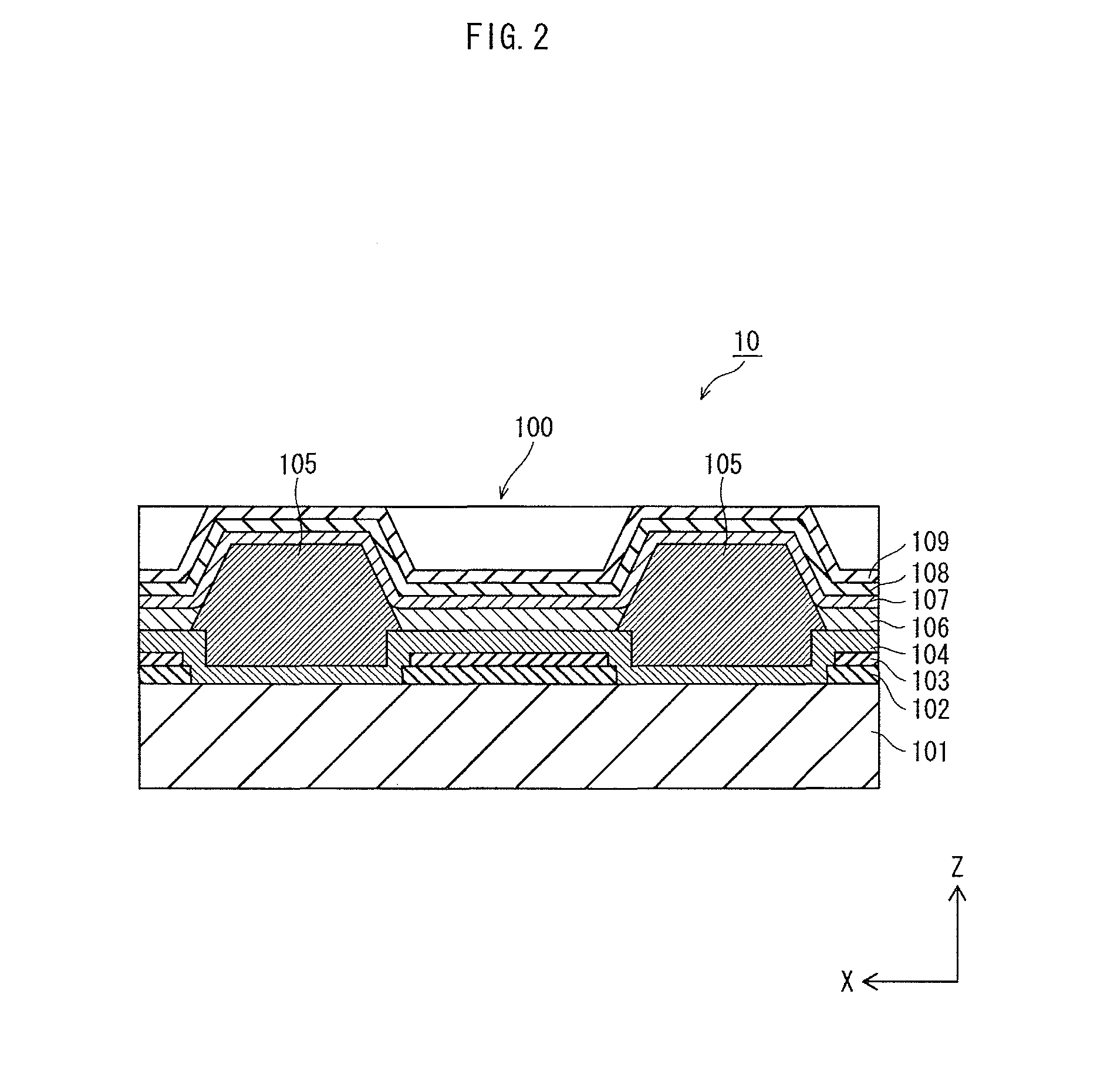Organic light-emitting panel for controlling an organic light emitting layer thickness and organic display device
a technology of organic light-emitting panels and organic light-emitting layers, which is applied in the direction of electroluminescent light sources, thermoelectric devices, electric lighting sources, etc., can solve the problem of difficult uniform layer thickness, and achieve the effect of increasing the ink vapor concentration
- Summary
- Abstract
- Description
- Claims
- Application Information
AI Technical Summary
Benefits of technology
Problems solved by technology
Method used
Image
Examples
embodiment
[0092]The following describes an example of an embodiment of the present invention with reference to the drawings.
[0093]Note that the following Embodiment is simply an example to clearly illustrate a structure of the present invention and the acts and effects thereof. The present invention is in no way limited to the following Embodiment except in its essential characteristic elements.
[0094]1. Configuration of Display Device 1
[0095]The overall structure of the display device 1 according to the present Embodiment is described with reference to FIG. 1.
[0096]As shown in FIG. 1, the display device (organic display device) 1 includes a display panel unit 10 and a drive control unit 20 connected to the display panel unit 10. The display panel unit 10 is an organic light-emitting panel that uses the phenomenon of electroluminescence occurring in organic material and is composed of a plurality of pixels arrayed two-dimensionally in the X-Y plane direction.
[0097]The drive control unit 20 is ...
modification 1
[Modification 1]
[0173]Next, with reference to FIG. 12, Modification 1 of the manufacturing method of the display device 1 is described. FIG. 12 illustrates processes corresponding to processes illustrated in FIGS. 9C to 10A.
[0174]As shown in FIG. 12, first a bank material layer 1050 is formed to cover the hole injection transporting layer 104, and then a mask 503 is placed above the bank material layer 1050. The mask 503 is provided with light transmissive portions 503a1, 503a2, 503b, 503c, 503d1, and 503d2. The light transmissive portions 503a1 and 503a2 are provided at locations corresponding to a portion in which the bank 105a is to be formed; the light transmissive portion 503b is provided at a location corresponding to a portion in which the bank 105b is to be formed; the light transmissive portion 503c is provided at a location corresponding to a portion in which the bank 105c is to be formed; and the light transmissive portions 503d1 and 503d2 are provided at locations corres...
modification 2
[Modification 2]
[0181]Next, with reference to FIGS. 13 and 14, Modification 2 of the manufacturing method of the display device 1 is described. FIGS. 13A to 14B illustrate processes corresponding to the processes illustrated in FIGS. 9C to 10B.
[0182]As shown in FIG. 13A, first a bank material layer 1050 is formed to cover the hole injection transporting layer 104, and then a mask 504 is placed above the bank material layer 1050. The mask 504 has openings 504a, 504b, 504c, and 504d corresponding to the portions at which banks 105 are to be formed.
[0183]The openings 504b and 504c are formed to have the same width as the openings 501b and 501c in the mask 501 used in the manufacturing method of the above Embodiment.
[0184]On the other hand, a width Wa3 of the opening 504a located between the planned sub-pixel formation region 1000a and the planned non-light-emitting cell formation region 1000d in correspondence with the bank 105a that is to be formed (see FIG. 4) is set to be larger tha...
PUM
 Login to View More
Login to View More Abstract
Description
Claims
Application Information
 Login to View More
Login to View More - R&D
- Intellectual Property
- Life Sciences
- Materials
- Tech Scout
- Unparalleled Data Quality
- Higher Quality Content
- 60% Fewer Hallucinations
Browse by: Latest US Patents, China's latest patents, Technical Efficacy Thesaurus, Application Domain, Technology Topic, Popular Technical Reports.
© 2025 PatSnap. All rights reserved.Legal|Privacy policy|Modern Slavery Act Transparency Statement|Sitemap|About US| Contact US: help@patsnap.com



